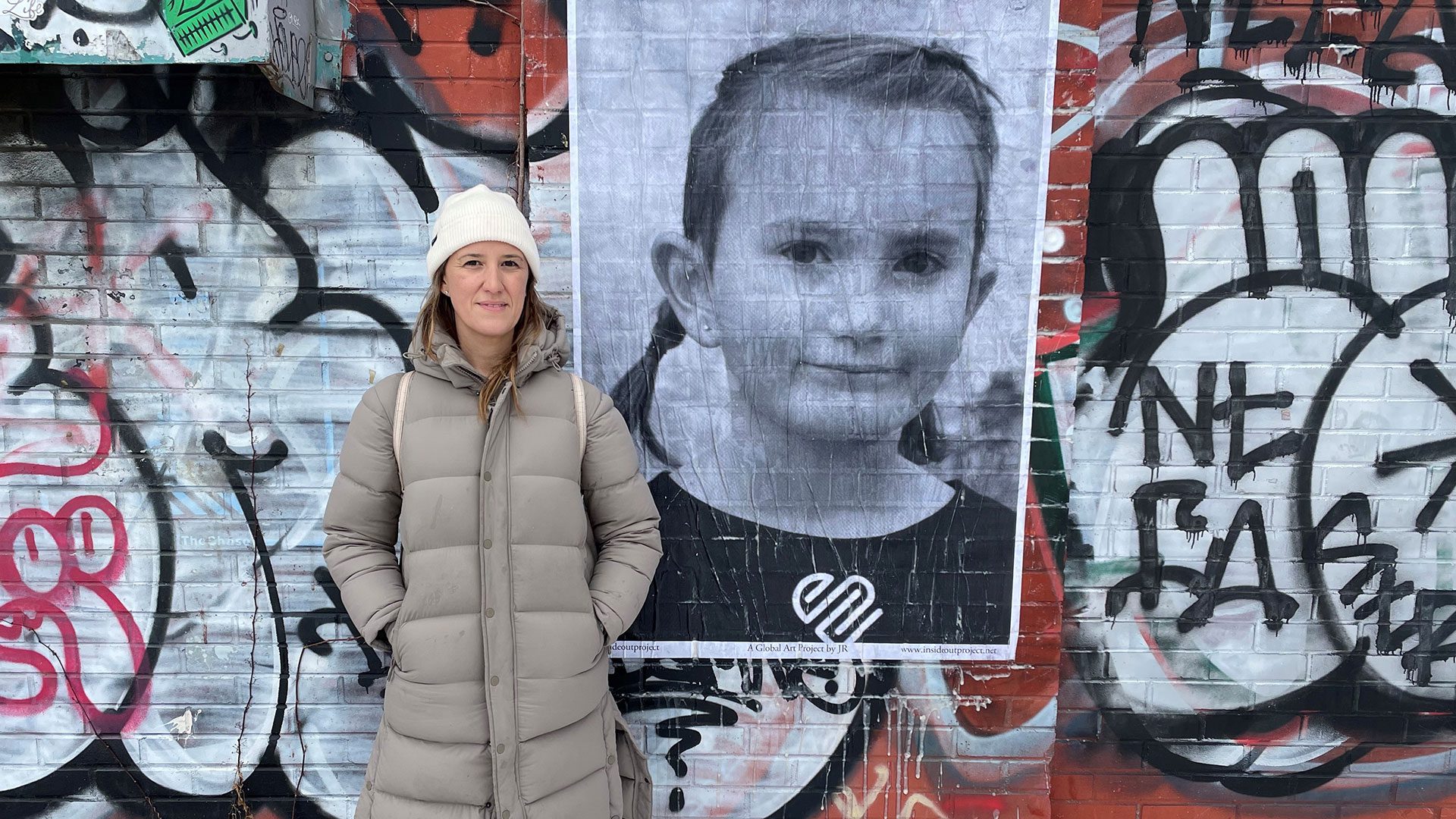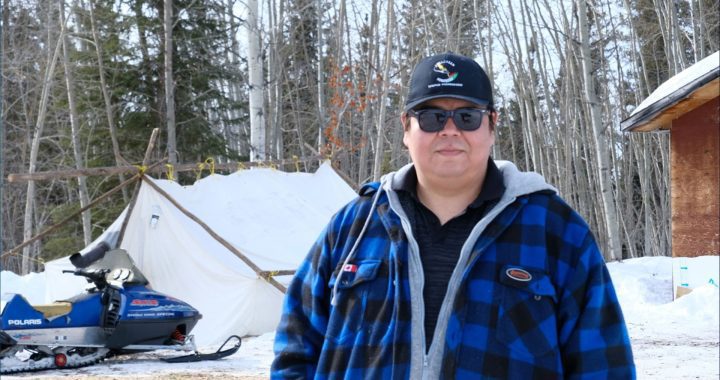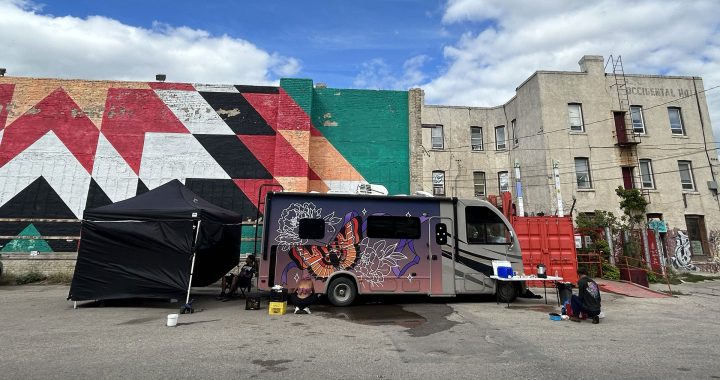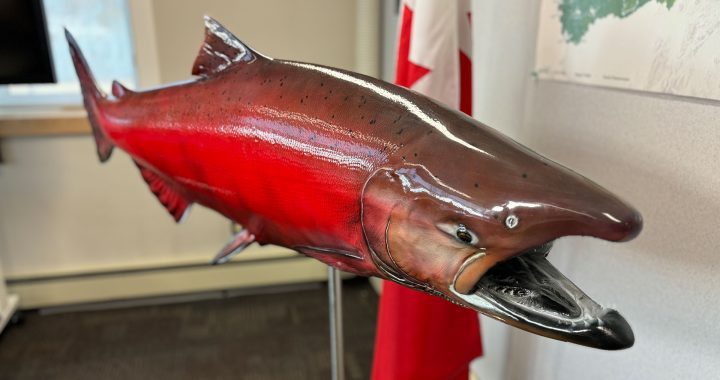Montrealers may have noticed some of the large portraits of Indigenous people that have appeared across the city over the weekend.
Black and white portraits of Indigenous faces of all ages stand outside by side against brick buildings. Their eyes looking out at the city.
An Elder with a headdress, a child laughing, and a young man smiling are some of the featured subjects.
They’re part of a public photography exhibit entitled Indigenous Forced Displacement.
MIND High School students spent part of their long weekend postering with Nakuset and her volunteers.
The team posted 18 portraits this past weekend.
The photo series is the brainchild of Nakuset, a prominent Montreal-based activist, and part of the Inside Out Project.
“That was really the whole idea of despite the fact that you did everything to kill us, this is the next generation, these are our future leaders, these are our knowledge keepers, these are the people that have survived, despite everything that you’ve done to us,” Nakuset said.

Inside Out is a global public art project that takes community concerns to an international level.
Started by French photographer and street artist JR, the installments are all made up of large-scale black and white portraits.
Normally it takes months for a submission to be approved by Inside Out, but when Nakuset submitted her proposal she heard back the next day.
“There aren’t many Indigenous people that actually apply, and this is the first one in Quebec. So, what I wanted to do was call it ‘Indigenous Forced Displacement’ because working in Montreal, I know the realities,” Nakuset said,
“We all know how many Indigenous people used to make up Canada and what the percentage is now. But I also wanted to have a project that shows that we’re thriving and that we’re still here.”
She said this uprooting of Indigenous people is ongoing.
“Because I work in and around the Cabot Square area, there’s condos that are going up, there’s a space in the park where there are a lot of Indigenous people, they’re getting forced out. And it’s a real shame, right? And where are they going to go?” said Nakuset.
Nakuset recruited volunteers and photographers to help with the project. She also reached out to the City of Montreal and some of her contacts to find buildings that could house the artwork.
Autumn Godwin is a volunteer with the project and a member of the Montreal Lake Cree Nation. She’s making sure her daughter Clara learns about her heritage.
Godwin said her daughter was happy to be on one of the posters.
“She’s super excited. She sees all the work that I’m doing, and she sees how passionate I am about everything, so I think she really gets into it, and it’s something we didn’t have growing up. So, I think for her, I get to see it through her eyes, too, so it’s pretty cool,” said Godwin.
The photos were taken by three Indigenous photographers.
Craig Commanda of the Algonquin Nation photographed primarily Indigenous youth, Ojibwe Vicki McDonald works around Cabot Square and found her subjects there and Martin Loft is a Mohawk of Kahnawà:ke. He mostly photographed Kahnawà:ke residents.
“I especially like photographing the Elders because when you see them and hear their voice and you’ve known them for a while, it’s kind of like it’s like home,” said Loft.

Loft said while Kahnawà:ke is well-established and prosperous, Montrealers can forget that the Mohawk community is so nearby.
“In a sense we never left. And you wouldn’t think that if you just got off the plane and came into downtown Montreal, or even for the people who live here. Like where are the Mohawks, where are the original inhabitants? Well, we’re right there. And with this exhibition it gives the opportunity to give it a face,” said Loft.
“We’re still here. We never went anywhere. Our ancestors trod these paths that became roads and paddled up the rivers that surround the island, and even grew corn at the foot of Mount Royal, and some of our remains are still under the ground,” he added.
Nakuset said despite the painful stories the topic of Indigenous displacement brings, the project was a positive experience.
“Every photographer whose picture is here is thrilled to have it, the models are happy to be here, the people that are pasting are happy to be part of it. You know, it’s either you’re part of the problem or part of the solution, and this is part of the solution,” said Nakuset.
Their work isn’t done. There are 50 posters in total — more will be put up in March.
Nakuset and her team received permission from building owners for the current posters. They are still on the hunt for more buildings in Montreal to host the portraits.
While the posters will fade over time, the project will live on Inside Out’s website permanently.
Visit the Indigenous Forced Displacement project’s Instagram to learn more. If you’re in Montreal, you can see the posters in person at the following locations:









